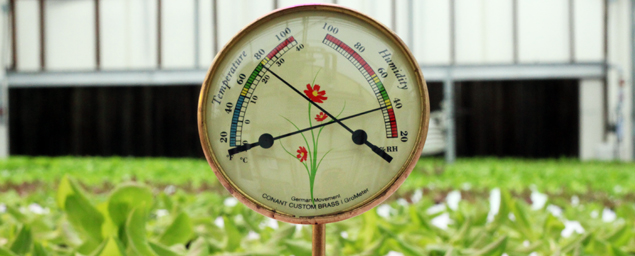Part 1: Rapid Relative Humidity Increases in the Greenhouse

When the relative humidity in the greenhouse environment either increases or decreases rapidly, the adaptation capabilities of the plants growing in the greenhouse environment may be challenged beyond the breaking point.
It’s the rate of change in the relative humidity rather than just the difference between the old relative humidity and the new relative humidity levels that can challenge the plant’s ability to adapt without resorting to sacrificing some of its tissue.
Rapid Increases in Humidity
In general terms, a rapid increase in relative humidity is a sizable change in a short period of time. Many factors enter into making a more precise definition of those terms, including the kind of plant being grown and the recent history of the relative humidity and temperature in the greenhouse.
For Example: A Bibb lettuce crop in a greenhouse where the relative humidity goes from 60% to 80% in 15 to 20 minutes, experienced a rapid increase in relative humidity and may suffer tissue damage in the form of the death of cells at the leaf margins.
What Happens To The Plant When Relative Humidity Increases Rapidly?
- It becomes harder for the plant to transpire water into the air.
- Water movement in and through the plant is slowed.
- The plant roots are the last to get the message and keep sending water up the line like they have been for the previous hour or two or three. This is one of the reasons that rapid relative humidity increases can be more damaging to plant tissue than the same increase in relative humidity spread out over a longer period of time. The longer period of time allows the plant to regulate the incoming water through the roots so that it matches more closely the loss of water from the leaves.
When Water Backs Up In The Plant Tissue
The calcium reinforced cell walls in the fully expanded and mature cells help prevent them from taking in too much water. Some additional water will be taken in by the cell but the cell will not rupture.
Cells in tissue where cell expansion growth is still occurring, however, have not yet had their cell walls fortified with calcium. As water is pushed into those cells they expand with little resistance from the non-fortified cell walls. If too much water is pushed into those cells, the cell walls rupture and that portion of plant tissue dies.
For Example: Leaf edges of plants like lettuce, cells in the blossom end of tomato and pepper fruit. Even the growing point of the lettuce can be killed by cell rupture. This happens very infrequently compared to other tissue damage caused by rapidly increasing relative humidity.
Factors Contributing To Rapid Relative Humidity Increase
- A rapid drop in greenhouse temperature will produce a rapid increase in the Relative Humidity in the environment. This can be brought about by different happenings.
- A cloud suddenly blocking the sun.
- A cold front coming through the location where the greenhouse is.
- A sudden rain shower or storm jacks up the relative humidity.
- In some locations, sunset.
- Running the wet wall too late into the evening.
- The wet wall turning on too late in the morning after the temperature has gone up too much and the relative humidity has gone down too far.
We'll talk about the effects of rapid relative humidity decreases in part 2 of this blog post. Be sure to watch our Facebook and Instagram for the latest posts, or better yet - sign up for our newsletter!
Greenhouse greenhouses